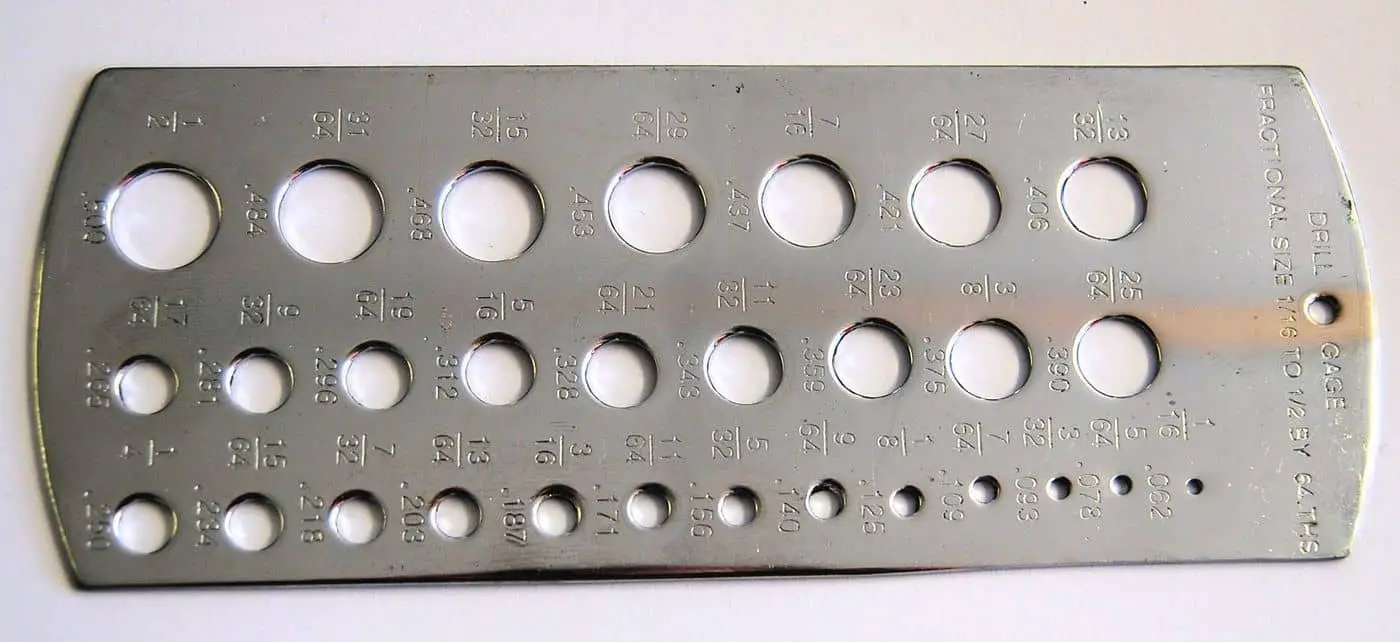First, let’s unravel the mystery surrounding this tool. A drill gauge, also referred to as a drill bit gauge, is a device that measures the size of drill bits. This instrument can be made of different materials, such as metal, plastic, or even hardened steel. It usually comes as a rectangular, oval, or round plate with a series of holes of various diameters. Each hole is accurately marked with the size of the drill bit to which it corresponds. The range of sizes available on a gauge can vary greatly depending on its intended use.

What is a Drill Gauge?
A drill gauge is a device used to quickly and conveniently identify the size of the drill bit. A drill gauge can be made of aluminum, steel, plastic, or wood. The indicator contains a series of holes that represent the bit’s sizes.
A drill bit is a cutting tool that removes problematic material to create a hole. It appears to have a circular cross-section. Drill bits vary in size and are attached to a drill. Every hole is marked with a measurement based on the bit size. The measurements are printed on top of the gauge.
What is the Use of Drill Gauge?
- Identification of Drill Bit Sizes: Drill gauges are primarily used to accurately identify the size of various drill bits, even when the markings on the drill bit are worn out or illegible.
- Selection of Appropriate Drill Bit: By determining the size of the drill bit, a drill gauge aids in selecting the appropriate bit for a specific task, ensuring precision in drilling operations.
- Maintaining Consistency: When making a series of holes of identical sizes, a drill gauge ensures that the correct bit is consistently used, ensuring uniformity in the results.
- Facilitating Safety: A drill gauge ensures you use the right drill bit for your drill and the material you’re working on. This increases the lifespan of your tools and reduces the chance of accidents that could arise from using an inappropriate or worn-out drill bit.
- Industry Applications: Drill gauges are invaluable across various industries, including woodworking, metalworking, automotive, aerospace, manufacturing, and construction. They contribute to quality control by ensuring consistent and precise use of drill bits.
- DIY Uses: A drill gauge can be handy for ensuring accurate and safe drilling, even for home-based DIY projects.
- Homemade Drill Gauges: In some cases, builders create their drill gauges for convenience by drilling holes into a piece of wood and marking them with the appropriate measurements.
- Checking Wear and Tear: Apart from measuring the size of drill bits, a drill gauge can also be used to check the level of wear and tear on bits over time, indicating when they might need replacement.
- Maintenance of Standards: In industries like manufacturing, where assembly lines depend on consistency and precision, drill gauges play a crucial role in maintaining standards and the overall quality of the finished products.
- Avoiding Damage: Using an incorrect or worn-out drill bit can damage the tool and the material being worked on. A drill gauge helps prevent such incidents by using the correct fit-for-purpose bit.
Drill Bits and Drill Gauges: Sizes and Applications
Understanding a drill gauge’s workings depends on knowing how drill bits vary based on size. Drill bits come in various sizes, and their diameters significantly affect their classification. Notably, measurements are provided in metric and fractional units, with metric drill bits prevalent in countries adhering to the metric system. In contrast, fractional sizes are commonplace in the United States and similar countries.
Drill bit sizes coincide with the wire gauge system. Ranging from 80 to 1 and progressing from A to Z, 106-bit sizes are available. The slightest bit is designated as size 80, and the largest carries a Z rating. Although some drill bits still carry gauge designations, most are labeled with either metric or fractional sizes.
Moreover, drill gauges may contain standard and metric measurements equivalent to fractional and metric sizes. This diversity of measuring systems embedded in the drill gauge is the reason for its name and underscores its role in demystifying the measurement of different bits.
Drill Gauges in Construction
In the construction industry, drill gauges serve multiple purposes. Notably, they are used to identify a bit’s size or determine the appropriate bit size for a particular task. When using a drill gauge, it is essential to remember that the tip of the drill bit should be slightly smaller than its body. This facilitates the efficient penetration of materials and saves time. Precise measurement is attained when the drill bit snugly fits into the hole in the drill gauge, accurately reflecting the bit’s size.
Ingeniously, some builders even create their drill gauges using a wood block. They select a sizable wooden piece and drill holes corresponding to each bit. Once all holes have been drilled, they are marked with the appropriate gauge or measurements.
Drill Types and Their Sizes
There are several types of drills, each with its unique characteristics and applications:
1. Screw Machine Length Drill: Apart from the larger drill bit sizes, there is a shorter variety known as the ‘Screw Machine Length Drill.’ These are typically used in screw machines. Compared to the standard jobber bit, their shorter length provides a more rigid drill bit that minimally deflects and is less likely to break.
2. Jobber Length Drill: This is the most commonly used type of drill. The flute length typically ranges from 9 to 14 times the diameter of the drill, depending on the size of the drill. “Jobber” refers to a wholesale distributor, reflecting this drill bit as a general-purpose, versatile tool.
3. Aircraft Length Drill: Also referred to as long series or extended drills, Aircraft Length Drills are usually used to drill deep into materials.
4. Center Drill Bit Sizes: Center drills come in two angles – 60 degrees and 90 degrees. The 60-degree bits are the standard for drilling center holes, while 90-degree bits are used to spot locations before drilling with twist drills.
5. Spotting Drill Bit Sizes: Spotting drills are smaller drills typically available in sizes ranging from 1/8″, 1/4″, 3/8″, 1/2″, 5/8″, 3/4″, 4mm, 6mm, 8mm, 10mm, 12mm, 14mm, 16mm, to 18mm. These drills come with either a 90 or 120-degree angle.
In conclusion, a drill gauge is pivotal in various industries, facilitating precision and safety in drilling tasks. Its design and functionality cater to a broad range of drill bit sizes, making it an indispensable tool in any builder’s arsenal.
In the vast universe of hand and power tools, the drill gauge stands as a hero unsung, often overshadowed by the more visually impressive implements like drills, saws, or even the humble hammer. Yet, the drill gauge is an irreplaceable ally for those who value precision and perfection in their work. This article explores drill gauges, explaining their function, application, and overall value in various professional and DIY contexts.
The Importance of Drill Gauges
Imagine you’re tasked with making a series of holes of identical sizes, but you’ve got an assortment of drill bits before you. How do you determine which bit is the right size? Eyeballing it won’t provide you with the precision required. Here’s where the drill gauge shines.
A drill gauge will accurately and quickly determine the size of your drill bit, ensuring that you have the correct bit for the job at hand. Consistent, precise hole sizes are critical in many applications, from woodworking and metalworking to the assembly of manufactured products and even DIY projects around the home.
Furthermore, drill bits can become worn or damaged over time, and their markings may become illegible. In such cases, the drill gauge again proves invaluable, allowing you to correctly identify a bit’s size despite the wear and tear.
How to Use a Drill Gauge
Using a drill gauge is relatively straightforward. You insert a drill bit into the appropriately labeled hole on the gauge. You’ve found the correct size if the bit fits snugly into the hole without any wiggle room. If the bit is too loose or doesn’t fit into the hole, you’ll need to try a different hole until you find the correct match.
Drill Gauges and Safety
Besides their application in precision work, drill gauges are vital in maintaining safety. Using an incorrect or worn-out drill bit can lead to tool damage, workpiece damage, and even personal injury. A drill bit that’s too large can cause a drill to torque or twist unexpectedly, potentially causing an accident. In contrast, a drill bit that’s too small may break during operation, creating a hazardous situation.
Using a drill gauge, you can ensure you use the right drill bit for your drill and the material you’re working on. This reduces the chance of accidents and increases the lifespan of your tools.
Drill Gauges in Different Fields
Drill gauges are not just limited to woodworking or metalworking; they also find extensive use in other areas such as the automotive, aerospace, manufacturing, and construction industries.
For instance, precise holes are needed for bolting parts together or for hydraulic systems in the automotive industry. A drill gauge ensures the correct drill bit creates these holes.
Drill gauges are critical in the manufacturing industry, where assembly lines depend on consistency and precision. They ensure that the right-sized drill bits are used consistently across multiple tasks and multiple workstations, maintaining the overall quality of the finished product.
What size drill bit for an eight gauge screw?
Drill Bit Sizes For Pre-Drilling For Screws Most Commonly Used Sizes In Bold are:
| Screw Size | Pilot hole size for hardwoods* | Pilot hole size for softwood** |
|---|---|---|
| #7 | 3/32" | 5/64" |
| #8 | 1/8" | 3/32" |
| #9 | 1/8" | 3/32" |
| #10 | 1/8" | 7/64" |
Conclusion
The drill gauge is a critical and versatile tool across numerous professional and DIY sectors and applications. With its primary function being to accurately identify and select the correct drill bit size for a specific task, a drill gauge proves invaluable in maintaining consistency, precision, and quality in drilling operations.
Safety, a non-negotiable aspect across all industries, is significantly enhanced using a drill gauge. It prevents inappropriate or worn-out drill bits that could result in accidents or damage to the tools and materials.
In terms of utility across industries, the drill gauge finds wide applications in woodworking and metalworking, manufacturing, automotive, aerospace, and construction. The tool’s importance in maintaining standards, especially in mass production environments, cannot be overstated.
Even beyond commercial uses, the drill gauge is valuable in home-based DIY projects. It facilitates accurate and safe drilling and potentially extends the tools’ lifespan by ensuring appropriate drill bit use.
A drill gauge is an indispensable tool that, though often underrated, plays a crucial role in various drilling tasks. Its significance lies in enabling precision and consistency and promoting safety and quality control across multiple domains.
- Facebook Ads to Get Followers! - December 27, 2024
- ClickUp vs. Slack - December 20, 2024
- Mastering E-Commerce Analytics: A Blueprint for Success






